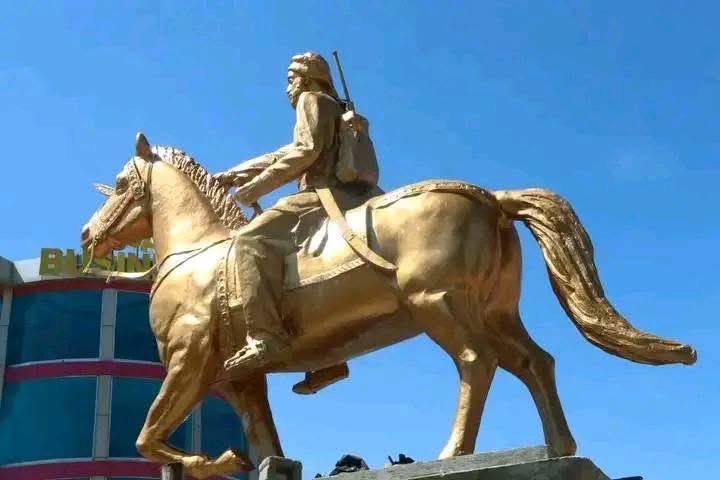Mekelle፡Telaviv, Nairobi, Pretoria, London, (Tigray Herald)
“Diverting Attention or Cultural Reckoning?
The Controversy Over Sayid Mohamed Abdille Hassan’s Statue in the Somali Region
By: Azim Hussein
In the Somali region of Ethiopia, a controversy is unfolding that has sharply divided the public and ignited heated debate across communities. At the heart of the issue lies a statue of Sayid Mohamed Abdille Hassan the iconic Somali nationalist leader and anti-colonial fighter revered by many as a hero, yet viewed by some as a divisive figure.
The question of whether the statue should be preserved or removed has sparked not only cultural and historical disputes but also accusations of political maneuvering at the highest levels.
This debate, however, may not be what it seems on the surface. There is growing suspicion among observers and residents that the statue controversy is a deliberate distraction crafted by the administration of Somali regional president Mustafe Muhumed Omer (also known as Mustafe Cagjar).
The timing is telling. The regional government iscurrently under mounting political pressure from Addis Ababa specifically from the federal administration centered in Arat-Kilo over issues ranging from governance short comings to regional autonomy.
The Political Backdrop
Tensions between regional states and the central government have been escalating in recent years, particularly around questions of self-determination, political marginalization, and resource control.
The Somali region, long underdeveloped and historically sidelined, has seen a surge in political activism and calls for reform. Amid this climate, Mustafe Omer’s administration has faced criticism for failing to addres score issues such as unemployment, infrastructure gaps, and internal displacement.
The timing of the statue controversy is thus seen by many as more than coincidental. Critics argue that it serves as a “manufactured debate” meant to deflect attention from these failures and redirect public discourse toward an emotionally charged but ultimately symbolic issue. By igniting divisions over the legacy of a polarizing historical figure, the administration may be seeking to fragment public unity and dilute growingdissent.
The Cultural Controversy
Sayid Mohamed Abdille Hassan, often called “The Mad Mullah” by British colonial authorities and “The Somali Lion” by his admirers, led a two-decade resistance against British and Italian forces in the early 20th century. To many Somalis, he embodies resilience, sovereignty, and pride in the face of foreign domination. His poetry, military leadership, and pan-Somali vision have left an enduring legacy in the Somali consciousness.
However, others argue that his campaigns also brought suffering and division among Somali clans, particularly due to his harsh treatment of those who opposed hismovement. For this reason, some view the public commemoration of Sayid Mohamed through statues as glorifying a figure whose actions sowed division and violence among Somalis.
The statue debate, therefore, is not purely political it also taps into long-standing historical wounds, identity politics, and competing visions of Somali heritage. Yet, evenin this context, the sudden push for the statue’s removal, allegedly initiated by Mustafe Omer’s administration, seems suspiciously timed.
A Deliberate Distraction?
For many in the region, this is not the first time a culturally sensitive issue has beenleveraged for political convenience. Government critics point out that this kind of tactic generating polarizing public debate to mask deeper political vulnerabilities has beenused before in various regions of Ethiopia.
The administration’s selective focus on symbolic issues rather than structural reformsfuels public frustration. Instead of addressing the root causes of instability and underdevelopment, the regional leadership appears to be engaged in a media-fueled battle over monuments and memorials a strategy that ultimately serves to dilute publicscrutiny.
What Comes Next?
The outcome of the statue debate remains uncertain. Protesters on both sides have mobilized some demanding preservation as a mark of Somali pride and history, other scalling for removal in the name of healing and progress. What’s clear, however, is that the issue has been weaponized in a broader political struggle.
As pressure continues to mount from Addis Ababa and from within the Somali region itself, the administration of Mustafe Omer may find it increasingly difficult to govern through distraction. Symbols matter, but they cannot substitute for responsive leadership, economic development, and inclusive governance.
If the government hopes to restore public trust, it must move beyond superficial debates and begin to address the systemic challenges facing the region.
The statue of Sayid Mohamed Abdille Hassan may stand or fall, but the true legacy of this moment will be determined by whether the administration chooses diversion or decisive action.Let us know your thoughts: Is the statue debate a legitimate cultural reckoning, or is itpolitical theater? Join the conversation below.
Azim Hussein
Email:azim29269@gmail.com
Azim Hussein is a freelance writer and governance advocate based in Jigjiga Somali region.


